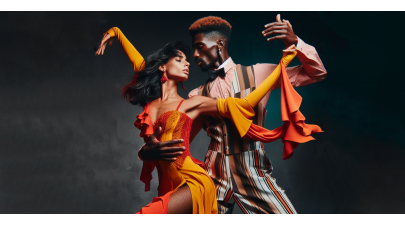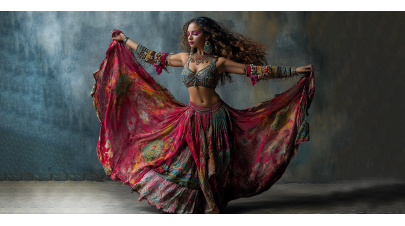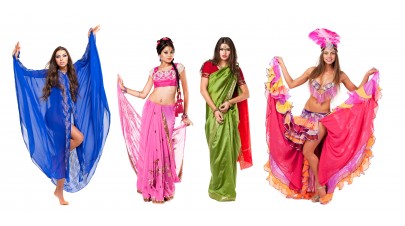Salsa dance
How about salsa?
And now I don't mean sauce, but the Cuban style of Latin-American dance, which will warm your blood in your veins :-) whether you are ten or seventy years old.
The steps are not difficult to learn and after a few basic lessons you can enjoy a perfect rhythm and pure joy of your own movement. Now I would like to write you a few words about salsa, it is good to know something about this dance before you go to the dance floor.
History of salsa
Salsa is one of the most popular Latin American dances, which is performed all over the world today. The salsa dance style appeared in a Central American country, specifically in Cuba in the late 19th and early 20th centuries. The country's rich musical history has allowed many Latin dances to flourish, grow and transform into new forms, leading to modern salsa dance and salsa music until the 1920s. Contemporary salsa as we know it has evolved from several earlier Cuban dance forms, including Son, Son Montuno, Mamba, Cha Cha Cha, and has also been enriched by Puerto Rican dance influences.
After the initial outbreak of popularity in Cuba and Puerto Rico, Salsa quickly spread throughout Latin America and the United States and became one of the most popular Latin dances.
Etymology of salsa
The full origin of the term "Salsa" has never been precisely determined. Although the same Spanish word has been used before when it was associated with Latin dance, the modern version of the name was promoted by marketing pressure from record companies and promoters who wanted to introduce the dance to the general public. In its earliest form, "salsa" is a Spanish term meaning "spice".
The word "salsa!" Has been used in Latin music since the mid-19th century as a cry that musicians shouted during their performances. The term was used in energetic songs that encouraged dancers and other musicians to become more frantic, acrobatic, introduce freestyle changes and "spice up" their act.
The term "salsa" could also mean the origin of a dance that can be traced to a combination of several other dances. Some music and dance historians believe that the term "salsa" has the same meaning as "sauce," meaning a mixture of ingredients used to create this dance.
The term "salsa" was promoted more by the international dance and music industry than by original Cuban artists and promoters.
Origin in Cuba
Although historians agree that modern salsa was born in Cuba at the turn of the 20th century, its exact roots can be traced several decades earlier in the region's musical history.
The basis of salsa was formed by countless immigrants who came to Latin America from different parts of Europe and African slaves who were transported against their will to Central America during the slave trade. At its core, Salsa was made from elements of troubadour music from Spain (Flamenco and others), Rumbas from African slaves, Danzón from France and immigrants from Haiti, and various instruments that were popular in Cuba. It is from African slaves that the characteristic drums and rhythmic instruments come, as well as the upright posture during the dance, which is quite common for Africans used to carrying all the load on their heads.
While Salsa conquered the Cuban population in the last years of the 19th century, other regions of Central America realized this during the early years of the 20th century. Tourists and musicians brought Salsa to several other countries in South and Central America, enabling this musical style to transform, grow and become an influential cultural heritage throughout Latin America.
How salsa is danced
For salsa, the rhythm is quick-quick-slow, they dance to 1-2-3 and 5-6-7, but there are also species with different rhythms 2-3-4, 6-7-8 . To dance salsa, listen to four times of music, but dance only the first three steps. The last time from the bar is "movement on decoration".
Body movement while dancing is as important as steps. The head is held upright during this dance and the hips and shoulders are wavy. In dances with a Caribbean past, such as salsa, the head and shoulders remain upright for as long as possible. The hips and shoulders should curl to the beat.
Salsa is a couple dance and women have it much easier than men. A man is the one who leads his partner all the time. In addition, salsa is an improvised dance (unless it is a learned set for a dance competition), so the dancer constantly invents further steps and dance creations and the woman is led throughout the oak.
So after you learn the individual figures with your partner, it's up to him at what moment to use them.
Plus, he's a man, who must constantly check the space around him where the woman is leading and what steps will follow. The woman can thus be said to rest, thinking of being beautiful and smiling while dancing.
I really think that such salsa classes will be enriched by more than one married couple, because here a man is a man and a woman is a woman.
Unfortunately, there are not many men in our country who would like to attend salsa classes with their wife. For men, such a dance usually doesn't come too masculine, and it's a shame, because salsa dancers impress us women very much. So if you're lucky and your husband accompanies you on salsa dance lessons, you've won and probably a wonderful hobby can be born for both of you, which will bring you closer and take your relationship to the next level. It's wonderful to be led by a man you love while dancing. If you do not have such a partner, you do not have to despair, you can either go to a group dance, where men and women gradually learn the basic steps and figures and then the dance partners take turns.
Or find salsa dance classes for individuals. Although salsa is a couple dance, a woman can also dance with a woman or everyone can dance alone.
Most dance classes begin in September and January. Feel free to find a salsa course in your area.
You will meet new friends, discover a new dance style, compare your figure and practice your whole body with a fun style.
What to wear to a salsa course (for women)
In the first salsa lesson, you will usually learn how your teacher will want you to wear clothes. Usually to master the first lessons, the teacher wants you to have tight pants or dance leggings (so that the work of the legs can be seen well), a tight T-shirt (so that the work of the hips can be clearly seen) and initially only dance exercises with a leather sole.
Once you have mastered the basic steps, you will be able to switch to dance shoes with a leather sole, which glides well on parquets with a medium-high heel, as well as dance Latin skirts and dance tops or straight dance Latin dresses. Dancing in such clothes has a completely different charge. You will feel the difference and enjoy your dance in shoes and Latin dance dresses and with a Caribbean-style visage. For these occasions, parties and several-day dance festivals are held in the world but also in all major cities in Salsa.
We are pleased to invite you to our store, where you will find everything you need for salsa, from professional dance shoes at reasonable prices, Latin dance dresses, tops, skirts but also dance pants and leggings as well as original accessories and decorations that are nowhere to be found. you won't find it anywhere else. You can now buy everything in the comfort of your home in our well-arranged shop HERE. And if the goods do not fit you, you can simply return them to us. The complete offer of salsa dance clothes can be found HERE.
Finally, I say goodbye to you with a quote from the Queen of Salsa herself (internationally known as Celia Cruz, who was the most popular Cuban singer of the 20th century):
“When opportunity presents itself grab it. Hold on tight and don't let go. "
(When the opportunity arises, grab it. Hold on tight and don't let go).






















